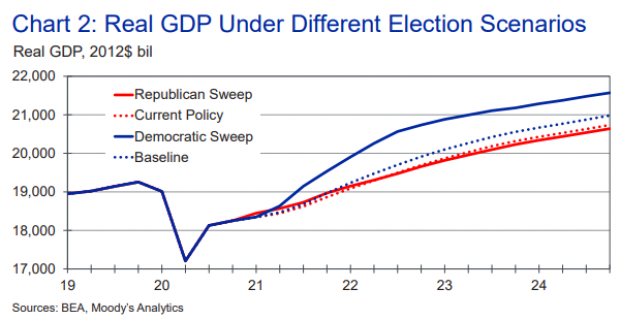The economy is widely seen to be a relative strength for President Trump, with voters giving him much higher approval ratings for his handling of economic issues than other areas. But a new analysis from economists Mark Zandi and Bernard Yaros of Moody’s Analytics says that Joe Biden’s economic agenda would spur more growth than Trump’s.
Using an economic model the authors say is similar to those deployed by the Federal Reserve and the Congressional Budget Office, Zandi and Yaros estimated the impact of the candidate’s proposed policies, including changes to the tax code, infrastructure spending and health care access. The strongest growth occurs in a scenario in which Biden is able to pass his agenda through a Congress controlled by his party:
“Largely because of Biden’s substantially more expansive fiscal policies, the economy would return to full employment more quickly coming out of the pandemic than under Trump—in the second half of 2022 under Biden compared with the first half of 2024 under Trump. Biden’s reversal of Trump’s policies on foreign trade and immigration would also contribute to stronger economic growth, so that by the end of their terms in 2024, real GDP would be $960 billion, or 4.5%, larger under Biden than Trump. This translates into 7.4 million more jobs under Biden than Trump.”
However, much depends on whether the election results in divided control of Congress. Zandi and Yaros considered four possible election outcomes, including clean sweeps (full control of the White House and both chambers of Congress by either party) and scenarios that involve divided government (Biden wins but the Senate stays in Republican hands, Trump wins but the House stays in Democratic hands). The strongest economic results are seen in the Democratic clean sweep scenario, which the authors give a 20% chance of occurring.
The other election scenarios result in weaker growth trajectories, and only modest differences overall (see the chart below). The election outcome the authors say is most likely — a Biden win with Republicans maintaining control of the Senate, which they give a 40% chance of happening — produces the second-best economic results over the next decade. Divided control with Trump keeping the White House is the third-best result, while the worst occurs with a Republican clean sweep.
Other notable findings from the analysis:
Biden’s policies favor the middle class: “Lower- and middle-income households benefit more from Biden’s policies than Trump’s. Biden ramps up government spending on education, healthcare and other social programs, the benefits of which largely go to those in the bottom half of the income distribution. Meanwhile, he meaningfully increases taxes on the well-to-do, financial institutions and businesses to help pay for it.”
While Trump’s favor the rich: “Trump largely does the reverse. He makes permanent the temporary tax cuts he implemented in his first term. The benefits largely go to higher-income households and businesses, while government spending is scaled back on healthcare and a range of social programs, the benefits of which go mainly to those with lesser incomes and wealth.”
Bigger deficits under Biden: “Biden’s policies will result in substantially larger federal budget deficits than Trump’s, particularly during their terms as president. Biden’s policies cost $2.5 trillion during his time as president on a static basis, while Trump’s add only a few hundred billion dollars.”
But the economic cost will be low: “Negative economic fallout from Biden’s larger near-term deficits is mitigated significantly. The reason: With the economy far from full employment and inflation moribund when Biden takes office, the Federal Reserve’s vows on employment and inflation mean it will keep interest rates very low for much of the next presidential term.”
And the debt-to-GDP ratio would be similar after 10 years: "[T]he stronger economic growth supported by Biden’s policies generates more tax revenue and less government spending. The results are dynamic budget costs of closer to $2 trillion during his term. The stronger growth and increase in GDP also mean that by the end of the decade, Biden’s and Trump’s policies result in a similar 130% publicly traded federal government debt-to-GDP ratio. This compares with 108% when they take office."





